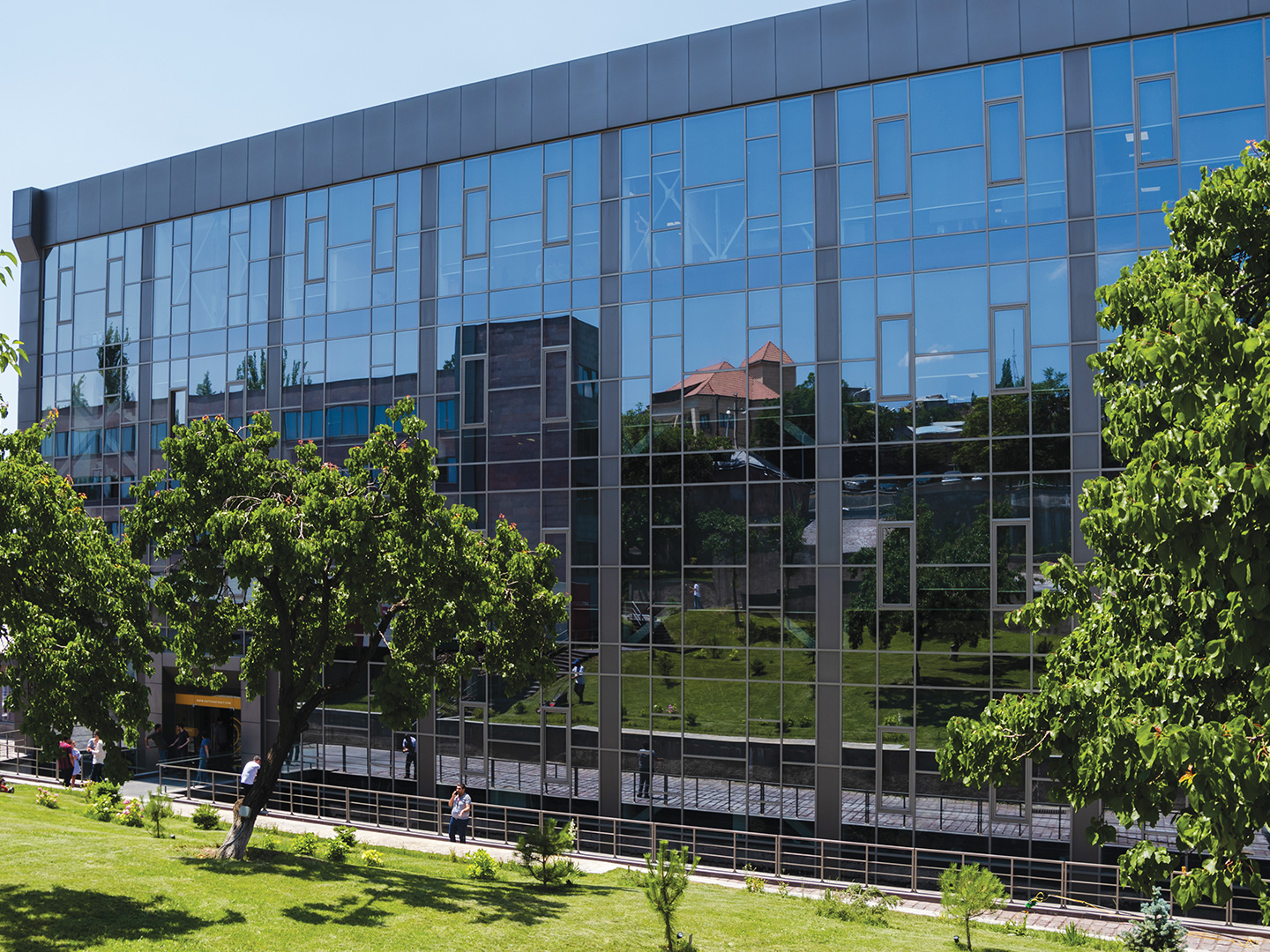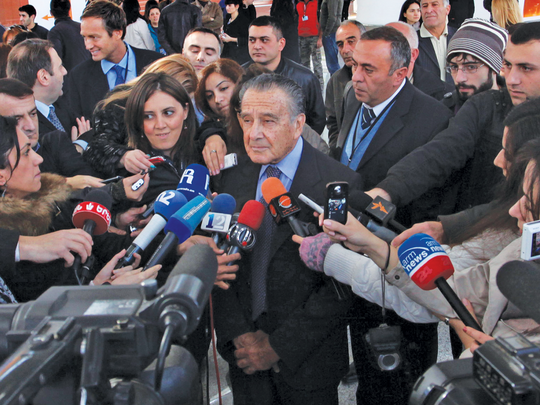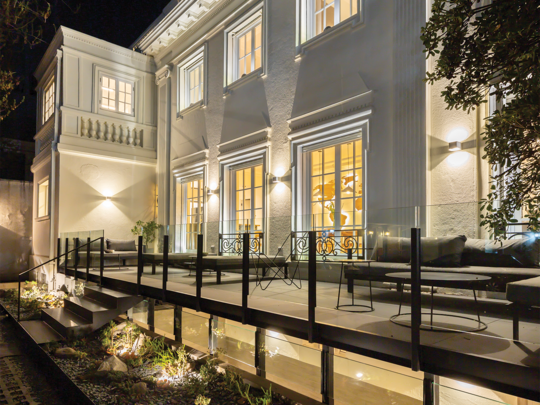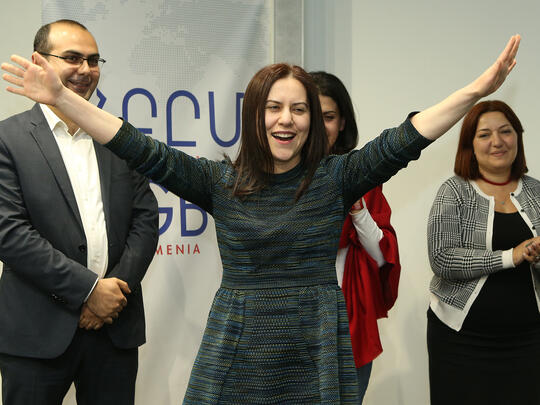Patrons stand in tight groups on the terrace in front of Rio Bar. Some are nursing drinks while others take long drags on cigarettes. One blurts something out in Spanish as the crowd bursts into laughter. Eventually, they elect to go back inside. For a brief moment, the muffled boom from the bar’s massive sound system clears to reveal the catchy rhythm of the latest reggaeton hit, before dissipating again with the closing door.
While this scene would be fitting for Rio’s iconic Ipanema neighborhood, Buenos Aires’ Palermo Soho or really any of Latin America’s major cultural hubs, the bar in question sits at the top of a narrow staircase on the intersection of Pushkin and Saryan streets in Yerevan, Armenia. If the new-found popularity of Latin American culture has resulted in the widespread export of Latin-style music, signature cocktails and dances to bars across the world, Rio Bar is not one of those.
“In fact, Rio Bar’s pulse is not so much a Latin theme, but a Latin identity,” insists Sarkis Panosian, the bar’s Uruguayan-born co-founder. Behind him, staff hurry to prep ingredients for the iconic milanesas, cut coconuts for their signature Pina Coladas, and test sound equipment on stage for the evening’s live Chacarera session. “I’m from Buenos Aires,” says one in markedly Spanish-inflected Armenian. “São Paulo,” answers another. Most unusual in Armenia is the cook’s hometown of “Caracas.”

With this revelation, Sarkis’ assertion of his establishment’s authentically Latin identity makes sense. Rio Bar isn’t an imitation—no matter how faithful—of the legendary speakeasys lining Recoleta’s Florería Atlántico street. It’s the real deal, just transported eight thousand miles away into the mountains of the Caucasus. While the investors, owners, cooks, barmen and staff may be Latinos—the ‘ian’ suffix to their last names which they all share betrays them as Armenians as well.
A century earlier, their ancestors, fleeing the Genocide ravaging their homeland, had settled in the South American boom towns of Buenos Aires, Santiago, São Paulo, and Caracas. The communities which they founded endure and even thrive today. If the younger generation feels more comfortable conversing in Spanish or Portuguese, they remain obstinately proud of their Armenian roots and traditions. However, others are trying to bring the traditions and innovations of their Latin-American experience to Armenia, as with Ari Hadjian, an Armenian-Argentine who repatriated to Armenia in 2010.
Products of Globalization
Of course, the realities of an increasingly interconnected and cosmopolitan world paint a much more complex picture of repatriation. A consequence of the close proximity between American and Hispanic communities across major American urban centres such as Los Angeles or New York, it’s quite common for young American-Armenians landing at Zvartnots to have at least one parent from Latin America (Armenian or otherwise). For these repats, like the Albuquerque-native Gabriel Alejandro Atjian—whose father is Argentine-Armenian and mother is Mexican—found the culture easy to adapt to. “The interesting thing is, I speak more Spanish here in Armenia than I do back in the States,” he chuckles.
In fact, Armenian ancestry may not even be a requirement for Latin Americans choosing to make a life for themselves in Yerevan. Some Latin dance aficionados in the Armenian capital have the distinct pleasure of taking classes from an authentic Colombian dancer. Monica Conde discovered Armenia when trying to learn Russian in Moscow. “While I was living in Russia, I would be regularly confused with an Armenian,” she says, “so when I finally decided to see what Armenia was all about, I ended up falling in love with the country and staying here.” Taking advantage of Armenia’s obsession with everything Latin, she started her own dance studio. “The main similarity between Armenians and Colombians is the temperament,” she recalls. “Armenians and Colombians are warm people who care about family and friendship.” With dancing being her passion, Conde feels like her studio is her own personal way of contributing to the deepening cultural contact between the two countries. “Here, I feel at home,” she says with a smile.

Style and Sensibility
“Growing up, I would never have described myself as an ‘Armenian-Argentine’, I was Armenian, full stop,” recalls Ari Hadjian. Still, he admits he can’t escape his Argentine upbringing even in his new home of Armenia. Now an architect at Corporación América’s Yerevan offices, Hadjian is part of Latin America’s increasingly conspicuous presence at the heart of Armenia’s cultural and economic development.
Corporación América, founded by yet another Argentine-born Armenian, the billionaire entrepreneur Eduardo Eurnekian, represents the single largest investment in the Armenian economy from Latin America. Aside from operating both of Armenia’s international airports—Zvartnots and Shirak in Gyumri—the company’s assets in the country include indus-tries as diverse as wineries and banking.
The Buenos Aires-based company’s sheer multitude of interests has provided Hajian with an opportunity to dip his pen into everything from contributing to the design of Yerevan’s state-of-the-art passenger terminal to bank buildings, hotels, schools and much more. “While it’s true that many local Armenians have a superficial appreciation for Latino culture,” he says, “other than the music, coffee, and dances, the deeper connection comes in the form of a shared mindset that can only be uncovered through the language of architecture.”
A graduate of University of Buenos Aires’ prestigious Facultad de Arquitectura, Diseño y Urbanismo, Hajian gained an appreciation for mid-century modernist design, a style which, a generation earlier, had become a signature mark of architects. “Latin American Modernism resulted from a mentality of deprivation,” he explains, “doing away with the need for frivolous ornamentation, these architects were free to design spaces which emphasized their human occupants.” This clean, functional aesthetic continues to influence his own designs in Armenia.
Latin America’s ‘do more with less’ attitude applies particularly well to Armenia’s architectural realities according to Hadjian. “The high-tech contemporary designs coming out of Europe are not-so-easily replicated in Armenia, due to the high cost of materials, and sophisticated maintenance requirements,” he remarks. Instead, he points to the simple yet elegant building techniques of Latin America’s most noted modernists as a source of inspiration.
“In my opinion, Latin Americans are second only to the Japanese as the world’s most visionary architects,” declares Hadjian. He hopes that architects in Armenia would take note from their innovative use of affordable, locally- sourced building materials to design geometrically simple, yet functional buildings. Naturally, the 40-year old porteño doesn’t expect those lessons to teach themselves. He points to his hard drive, which is full of blueprints for affordable and sustainable structures of his own design using simple local materials and clever natural lighting.
That said, Hadjian’s repatriation to Armenia has injected more than a little Latin flavour into the local architecture. Married to another Armenian repat, this time from Iran, Hadjian says that his twin sons, while born in Armenia, will grow up speaking Spanish and enjoying fútbol.
Employers and Investors
As Hadjian introduces his children to San River Plate F.C. soccer chants, another Argentine repat, Hrant Akopian, is pushing rival Lorenzo F.C. among his local colleagues at Converse Bank—another Corporación América venture. Since taking a position at one of Armenia’s largest financial institutions, Akopian has witnessed the creeping fusion of Argentine business practices with local Armenian culture at the office. Aside from his employees’ sudden interest in Cinco Grandes association soccer, and increasing fluency in the Spanish language, Akopian praises “the great improvement in Armenia’s business culture” since his last visit almost a decade earlier.

Unlike most repats from Latin America, Akopian is actually born in Armenia. The son of Soviet, and later Armenian diplomats, he was in Buenos Aires in 1993 when his father inaugurated the first-ever Armenian embassy to the country. From that point on, he was quickly adopted into the local Armenian community, attending the local AGBU Marie Manoogian High School before pursuing a bachelor’s degree in economics from the prestigious University of Buenos Aires. It wouldn’t be until completing his MBA at Columbia University that Akopian would fufill his lifelong dream of repatriating. “I found myself turning down any career opportunity which didn’t offer the possibility of working in Armenia,” he says. This opportunity presented itself in 2016, as the position of chief financial officer at Converse Bank in Yerevan.
If Armenia’s improved business environment has been enough to convince the son of diplomats from Argentina to repatriate, repats from Latin America have also been instrumental as cultural ambassadors in the fostering of fresh business ties between the old country and the Spanish-speaking world. This new reality has been most evident in the tech sector—Armenia’s window to a borderless world.

For many Latino repats, Armenia has turned out to be an unexpected land of opportunities. Joomag, a major Yerevan-based company which develops all-in-one digital publishing solutions, is part of a new trend among Armenian tech firms looking to break into the global Spanish-speaking market. The company has been actively recruiting people with native Spanish language business speaking and writing skills for its product team in recent years. Another Armenian tech giant, the photo-editing app developer PicsArt, has been building its Spanish- speaking product and customer success teams for years now. SoftConstruct, one of the world’s largest betting software developers, took it even further in 2016 when it opened its first Latin-American offices in the Uruguayan capital of Montevideo—home to 19,000 Armenians.

Roadblocks and Bridges
While repatriation from the large Latin- American diaspora remains modest, its impact is already being felt across Armenia. Still, in the minds of many Armenians in Buenos Aires or Mexico City, Armenia remains far removed from daily life, while language and distance remain significant obstacles for meaningful repatriation. Recent figures indicating stubborn economic growth in the homeland provide an inkling of hope that at least some in the Diaspora might be tempted to make their grandparents’ journey in reverse.
Indeed, the head of one Armenian family from Venezuela sitting at the passport and visa office in Yerevan says, “Armenian citizenship is the best option for us right now.”
Banner photo by Davit Hakobyan




















